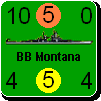Shannon V. OKeets
Posts: 22095
Joined: 5/19/2005
From: Honolulu, Hawaii
Status: offline

|
quote:
ORIGINAL: Gravit
The theme that I am beginning to see with awesome ADG boardgames Matrix-ized is that they are being done by one-person operations.
One project manager can PM more than a single product development project. If Matrix had one PM responsible for all of the games in development then the actual costs to this project wouldn't be $100,000. A $110K/year PM can run 10-15 projects of this nature, making the actual project cost around 8K per year. A PM would provide realistic work breakdown, accurate status reporting and milestones that are met. Issues would be tracked and risks would be mitigated.
A second addition would be to have a Business Analyst added to in-development projects. A good 80K/year BA should be able to work on 5-10 projects of this magnitude simultaneously and could handle all touchy-feely communications, polls on what the customer wants, etc. The BA cost slice for this development would run about 12K a year.
This leaves the main developer with all of the time dedicated to coding. This would at least double his productivity, most likely tripling it for a mere $20K/year. It is absurd to claim that it takes 100K+ per year to increase productivity or that a dozen staff have to be hired and a new coffee machine installed with a putting green in a glass office to provide quality results on time.
The result is no ramp-up time needed, no arguing with another developer, etc. The PM manages, the BA handles all requirements gathering and the developer codes. You don't need to toss programmers at this project, what this project (and EIA) needs is proper project management techniques and developers who code, not try and wear three hats at once.
I'm just curious that with the failure of EIA to deliver a playable product and the continuous delays to this one why ADG hasn't taken their licenses back and re-sold them to a company that properly manages projects to provide quality results on time and within budget. Hopefully ADG has this in their license with Matrix and take the proper steps needed to publish a realistic delivery milestone and get it done with with good quality.... and if Matrix fails to deliver on time with good quality then yank the license and go shopping around to another company such as 38 studios.
You are using a very simple management model.
Take a look at the rules for WIF and compare it to any other computer game. Then go back and rethink the tasks for your Business Analyst for requirements gathering. For instance, besides the basic Rules as Written document, there is the recent list of 360+ items from Harry Rowland on corrections and clarifications - those are the just design specifications for the simulation.
That does not cover the user interface, such as screen layouts, graphics, and how the player interacts with the program using the mouse and keyboard. There are over 100 forms for WMIF. Try comparing that to the number of forms in any other application you have ever used. Most war games have less than 20; "real-time war simulations" get by with 1 primary form/screen plus a few extras.
The increase in complexity as the number of rules increases is not linear, but at least geometric. Your BA is not going to be running 5-10 projects of this complexity each year. Take a look at the discussion today on Narvik, Liverpool, and Istanbul. The BA would not be a useful addition there - just one more person to whom everything would have to be explained.
Matrix does have a project manager running multiple projects, but he does not work down at the level you are suggesting: monitoring code development. That is because Matrix primarily takes nearly-finished games and then 'markets' them. That is their business model, with games like EIA and WIF exceptions to how they normally work.
So your idea that a PM can monitor 10-15 projects of this size down at the level of code development is unrealistic. For MWIF I have over 250 code modules containing 260,000 lines of code. I suspect that my 3-4 page weekly status report to Matrix contains a lot more detail than they want to read every week.
Even so, that level of reporting does not get down to the details you are assuming the PM will manage: "realistic work breakdown, accurate status reporting, and milestones that are met". [Wow, does that bring back memories of when I got my MBA: using adjectives that have emotional impact but add little or no substance.]
But rephrasing your idea as: a detailed task list (no more than 100 hours per individual task), hours per task, schedule for starting/ending each task, hours worked per week on each task, and milestones (assume these are clearly defined or they wouldn't be milestones). That is what I revise monthly (semi-monthly for the past few months) and what I report on weekly to Matrix. To offload that work to someone else would require that someone else to be very knowledgeable at least at the level of what each of the 250 modules and 100 forms does. He should also have an excellent understanding of the rules for MWIF or he will be hopelessly lost comprehending what is happening.
MWIF is not a run-of-the-mill game that can be punched out cookie cutter style: one of 10-15 projects, one of 5-10 projects. That would be nice but it isn't the case.
======
And about these comments that I am doing this alone, there are a couple dozen people I am in communication weekly who are doing work more or less under my direction. These are all unpaid contributions, but the time and effort they spend is quite real and so are the contributions they have made/make to the product. It's all that "touchy-feely" stuff, you see, that has resulted in thousands of hours of unpaid assistance. It's all that "touchy-feely" stuff, you see, that has resulted in thousands of hours of unpaid assistance.
_____________________________
Steve
Perfection is an elusive goal.
|
 Printable Version
Printable Version






 things in here so that people can see I'm joking.
things in here so that people can see I'm joking. 
 Andy (Sabre21) could use help with the naval units. Send him a PM to get started.
Andy (Sabre21) could use help with the naval units. Send him a PM to get started.
 It's all that "touchy-feely" stuff, you see, that has resulted in thousands of hours of unpaid assistance.
It's all that "touchy-feely" stuff, you see, that has resulted in thousands of hours of unpaid assistance. 




 ! That's what I told our son and our grandsons when we were driving somewhere on vacation and they became impatient. Keep up the good work and this is another game I'll buy from Matrix et al.
! That's what I told our son and our grandsons when we were driving somewhere on vacation and they became impatient. Keep up the good work and this is another game I'll buy from Matrix et al. 







 New Messages
New Messages No New Messages
No New Messages Hot Topic w/ New Messages
Hot Topic w/ New Messages Hot Topic w/o New Messages
Hot Topic w/o New Messages Locked w/ New Messages
Locked w/ New Messages Locked w/o New Messages
Locked w/o New Messages Post New Thread
Post New Thread